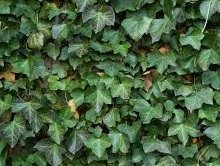 The Latin word hedĕra came into Spanish as iedra or iedra . This is the name given to climbing plants that belong to the Araliaceae family group.
The Latin word hedĕra came into Spanish as iedra or iedra . This is the name given to climbing plants that belong to the Araliaceae family group.
Like the rest of the Araliaceae, ivy is phanerogamous , angiosperm and dicotyledonous . This means that its reproductive organs can be seen in the form of a flower (phanerogamous); that its carpels develop an ovary that contains the ovules (angiosperm); and that its embryo has two cotyledons or leaves (dicotyledonous).
Ivy's roots sprout from its trunk and attach to nearby objects . Its leaves are black-green, while its flowers are greenish or yellowish. These plants also bear a berry -shaped fruit.
It is important to note that ivy is not a parasitic organism. However, because of its foliage it can cause damage and even suffocate the trees to which it entangles.
When grown from the ground, plants usually do not exceed 20 centimeters in height. On the other hand, when they can climb a tree or some structure (a fence, a wall, etc.), they sometimes grow more than 30 meters.
Thanks to its evergreen foliage, ivies are often grown to cover walls for ornamental purposes. In certain places, however, there are species of ivy that are classified as invasive, since they can grow uncontrolled and invade wild regions.
Ivy as an ornamental plant is as suitable for indoor as outdoor decoration, since its leaves withstand the lack of light without problem. On the outside, it is common to use it to cover facades and walls. Its origin is the European continent and only two of its few varieties are suitable for indoor cultivation: Canary ivy (also called Canariensis ) and common ivy (called Hedera Helix ).
One of the first questions that people interested in using ivy to decorate the interior of their homes or offices ask is what is the best place to place them . Well, since they do not require a lot of light for their development , we know from the beginning that we do not need to place them near a window, and this considerably expands the possibilities compared to other plants.
Of course, it is not advisable to leave them in very dark areas, as this can cause the leaves to lose color . It is also important that the chosen site is quite humid and that no drafts pass through there.
 Another frequently asked question is how to manipulate the shape of the ivy to obtain the desired results . In this case there are several ways, one of which is pruning ; Although this slows down the growth of the plant, it makes it more compact. It is also possible to nail several guides into the substrate so that the ivy adopts the shape we are looking for in a more natural way.
Another frequently asked question is how to manipulate the shape of the ivy to obtain the desired results . In this case there are several ways, one of which is pruning ; Although this slows down the growth of the plant, it makes it more compact. It is also possible to nail several guides into the substrate so that the ivy adopts the shape we are looking for in a more natural way.
We should not abuse pruning, but practice it a maximum of twice a year, especially in the hottest times or when we are about to change the pot of ivy . Both practices are favorable for stem strength and leaf density. The best time to transplant it is spring, and it is recommended to do it every two years at most.
It should be noted that ivy berries are toxic to humans . That is why its intake causes vomiting, diarrhea and other intestinal problems. In very high doses, it can even cause cardiac arrest.
For dogs, cows and other animals , ivy is also poisonous. Some birds, on the other hand, consume the berries and then contribute to the dispersal of the seeds and the propagation of the plant.
